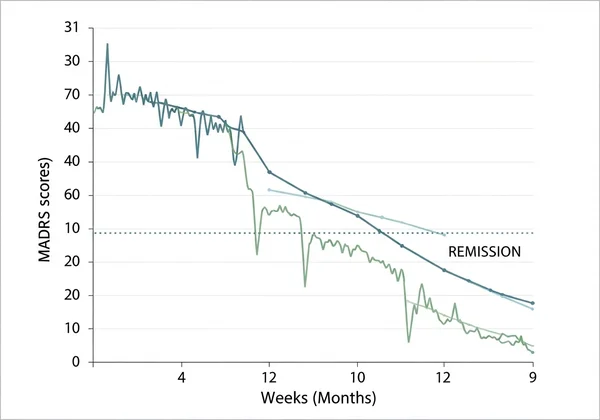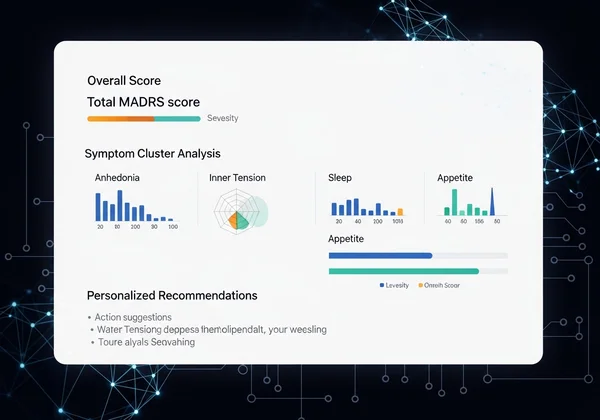MADRS Case Study: Tracking Depression Treatment Progress
The path through depression treatment can often feel uncertain. Days of clarity can be followed by moments of doubt, making it difficult to gauge whether you are truly moving forward. Progress can be subtle and hard to measure with feelings alone. What is the MADRS scale? It is a clinically trusted tool designed to bring objectivity to this journey. This hypothetical case study of "Sarah" illuminates how a structured tool like the Montgomery-Åsberg Depression Rating Scale (MADRS) provides a clear, data-driven approach, empowering both individuals and clinicians to monitor symptom changes and assess treatment effectiveness over time. Follow along to see how you can gain similar clarity on your own path by using our free MADRS assessment.
Introducing Sarah: Initial Assessment & Treatment Goals
We first meet Sarah, a 32-year-old graphic designer, when she decides to seek help for a persistent low mood, lack of energy, and a loss of interest in her creative work. Her doctor suggests using the MADRS scale to establish a baseline understanding of her symptoms. This initial step is crucial, as it provides a starting point against which all future progress can be measured. It transforms a vague feeling of being "unwell" into a quantifiable score.
What is the MADRS Scale? Understanding Baseline Scores
The MADRS (Montgomery-Åsberg Depression Rating Scale) is a ten-item diagnostic questionnaire used by clinicians to measure the severity of depressive episodes. Each item, which covers symptoms like apparent sadness, inner tension, and concentration difficulties, is scored from 0 to 6. Sarah sits down to take the test on our online platform. The process is straightforward and takes only a few minutes. Her initial score is 31, which falls into the "severe depression" range. While the number is concerning, it is also validating. It gives a name and a weight to what she has been experiencing, providing a solid foundation for her mental health journey.

Setting a Path: Sarah's Treatment Plan & Early Expectations
With a clear baseline, Sarah and her healthcare provider co-create a treatment plan. It includes weekly therapy sessions and starting an SSRI medication. The goal isn't to magically drop her score to zero overnight, but to see a gradual, steady reduction over the coming weeks and months. They agree that Sarah will use the online MADRS test weekly to track her progress. This regular check-in creates a structured routine for monitoring her treatment effectiveness and facilitates more productive conversations with her therapist and doctor.
Monitoring Progress: How MADRS Scores Reflect Change Over Time
The real power of the MADRS scale is revealed when it's used consistently. For Sarah, her weekly scores become a reliable map of her recovery journey, highlighting improvements, identifying challenges, and guiding necessary adjustments to her treatment. It provides objective data that complements her subjective feelings, offering a more complete picture of her well-being.
The First Few Weeks: Identifying Initial Responses with the Online MADRS Tool
In the first three weeks, Sarah's scores fluctuate. Her second week score drops to 28, but her third week score goes back up to 29. She feels a bit discouraged, but looking closer at the individual item scores on the MADRS tool, she and her therapist notice something important. Her score for "lassitude" (a feeling of weariness) has consistently improved, even if her "inner tension" score remains high. This granular insight from her regular symptom tracking shows that the treatment is having a positive effect, even if the overall feeling is not yet one of complete relief.
Mid-Treatment Insights: Recognizing Plateaus, Setbacks, and Adjustments
Around the two-month mark, Sarah's progress seems to stall. Her MADRS score hovers around 22 for a few weeks, indicating moderate depression. She feels better than when she started, but a sense of being "stuck" sets in. This is where the objective data from the MADRS becomes invaluable. By presenting these consistent scores to her doctor, they decide to make a small adjustment to her medication dosage. This decision is not based on a single bad day but on a clear pattern revealed through consistent MADRS score change tracking. You can discover your results and track your own patterns with our tool.

Sustained Improvement: Confirming Remission and Maintaining Well-being
Over the next few months, Sarah’s score begins a steady decline. At six months, she scores a 9, placing her in the remission category. This milestone is a powerful confirmation of her hard work and the effectiveness of her treatment plan. She decides to continue taking the MADRS assessment monthly, not as a sign of fear, but as a proactive tool for maintaining her well-being. It empowers her to stay attuned to her mental health and catch any potential slips before they become significant setbacks.
Beyond the Numbers: Our Platform's AI Reports for Deeper Insights
While tracking the MADRS score provides essential data, understanding the story behind the numbers can unlock another level of progress. Our platform offers an optional, AI-powered report that transforms a numerical score into a personalized narrative with actionable advice. Sarah opts to get her report to gain a richer understanding of her results.
How AI Decodes MADRS Results: Pattern Analysis & Symptom Clusters
The AI analysis does more than just interpret a single score. It analyzes the specific patterns in Sarah's answers. For example, it highlights that her challenges are primarily clustered around anhedonia (reduced interest) and inner tension, while her sleep and appetite have remained relatively stable. This helps her focus her therapeutic efforts on specific areas. This level of detail provides personalized insights that go far beyond a simple total score, making her recovery more targeted.
Empowering Action: Personalized Recommendations from Your AI Analysis
The most valuable part of the AI report for Sarah is the "Action Recommendations" section. Based on her unique symptom profile, the report suggests concrete, evidence-based strategies. For her challenges with anhedonia, it recommends scheduling small, pleasurable activities. To address inner tension, it suggests mindfulness exercises and journaling prompts. These aren't generic tips; they are tailored to her specific MADRS results, making them feel relevant and empowering. This feature helps bridge the gap between assessment and action, a key step in any healing process. To see what insights you could unlock, start your assessment today.

Your Journey to Clarity, Empowered by the MADRS Tool
Sarah's story is a testament to the power of combining professional guidance with objective self-monitoring. The MADRS scale provided her with a compass, transforming a journey that felt overwhelming and abstract into a manageable, measurable path toward recovery. By consistently tracking her symptoms, she was able to celebrate small victories, make informed treatment adjustments, and build confidence in her ability to manage her mental health.
Your journey is unique, but the need for clarity is universal. Whether you are just beginning to explore your symptoms or are actively in treatment, using a trusted clinical tool can be a game-changer. We invite you to try MADRS.net today to take the first step. Gain a clearer understanding of your emotional well-being, track your progress over time, and discover the personalized insights that can empower your path to recovery.

Disclaimer: This case study is for illustrative purposes only and does not represent a real individual. MADRS.net is an informational tool and is not a substitute for professional medical advice, diagnosis, or treatment. Always seek the advice of your physician or another qualified health provider with any questions you may have regarding a medical condition.
Frequently Asked Questions About MADRS Tracking & Treatment
Can I use MADRS for self-assessment to track my depression treatment?
Yes, absolutely. While the MADRS was designed for clinical use, it is an excellent tool for self-assessment to monitor your symptoms between appointments. Using our platform allows you to consistently track your score and share this valuable data with your healthcare provider, leading to more informed and collaborative conversations about your treatment plan.
How accurate is the MADRS scale in monitoring treatment progress?
The MADRS is considered a "gold standard" in clinical settings for its high sensitivity to changes in depressive symptoms. It is highly reliable and valid for monitoring treatment response over time. Its accuracy lies in its ability to quantify changes in core depressive symptoms, providing an objective measure to complement your personal feelings and experiences.
What is the difference between MADRS scores indicating improvement vs. relapse?
Improvement is typically shown by a steady decrease in your total MADRS score over time. A reduction of 50% or more from your baseline score often indicates a significant response to treatment. Conversely, a relapse might be indicated by a sustained increase in your score after a period of remission or improvement, suggesting a return of significant symptoms. Regular tracking helps identify these trends early.
Is using our MADRS tracking tool for treatment free?
Yes, the core MADRS assessment on our platform is completely free. You can take the 10-question test and receive your score instantly without any cost. We also offer an optional, in-depth AI-powered analysis for a fee, which provides the personalized insights and actionable recommendations discussed in the case study. You can take the free assessment anytime.
How do clinicians typically use MADRS scores to adjust treatment plans?
Clinicians use MADRS scores as objective data points to guide clinical decision-making. If a patient's score is not improving after an adequate trial period with a specific treatment, a clinician might consider adjusting medication dosage, changing the type of therapy, or exploring other interventions. The scores help them determine if a treatment is effective, partially effective, or ineffective, ensuring the plan is always optimized for the patient's recovery.